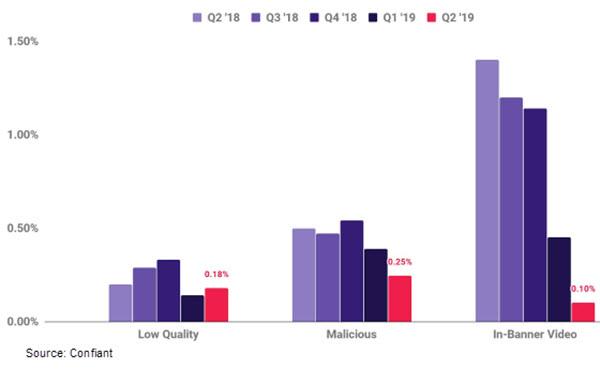
Amid all of the headlines about ad fraud
comes some reasonably good news, for a change: Both malicious ads and surreptitious in-banner video ads were down significantly in this year’s second quarter.
That’s according to
Confiant’s Demand Quality Report for the period. The real-time ad-quality verification vendor tracks the quality of
programmatic advertising on an ongoing basis, using a normalized sample of more than 120 billion impressions.
Malicious ads — defined as creative that includes (usually obfuscated)
Javascript that spawns a forced redirect or loads a secondary or tertiary payload for similar malicious purposes — fell to 0.25%. That’s down from 0.39% in Q1, and a high of 0.54% in Q4
2018.
“There continues to be a huge gap between the best and worst performers,” adds the report. “Among top SSPs, the worst performer is over 60 times as likely to deliver a
malicious ad as the best performer.”
Also, weekends and holidays continue to experience a higher rate of incidents. The rate of malicious ads by day ranges from a low of 0.13% on
Thursdays to a high on 0.44% on Sundays, by a factor of more than three times.
Most malicious ads are designed to force users to interact with phishing scams, but some perform
“crypto-jacking,” or infect the user’s device to propagate botnets and other nefarious activities.
In-banner video ads, or IBVs — ads loaded within a banner as a
display unit instead of playing within a media player, served in banners without the publisher’s (and often without the advertiser’s) consent — dropped to 0.10% in Q2.
That’s down from 0.45% in Q1 and a high of 1.4% in Q2 2018.
“If this trend continues, in-banner video ads can be expected to be all but extinct by the end of 2019,”
observes Confiant.
Now for the not-great news: The incidence of “low-quality” ad creative ticked up during the quarter, to 0.18%, from 0.14% in the first quarter.
However,
that was still down significantly from a high of 0.33% in last year’s fourth quarter. (The low-quality stat excludes a heavy ads comparison, as that data was not available for previous
reports.)
Low-quality ads are ones with creative violations across 16 different quality specifications selected by publishers. The dimensions include audio/video related violations, creatives
probing for user’s geolocation, ad the network load of the ad, among others.